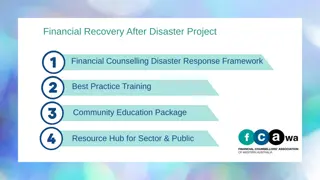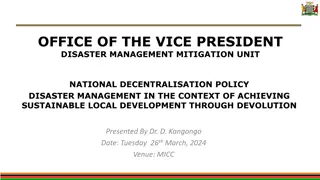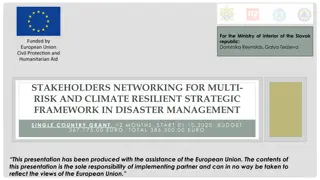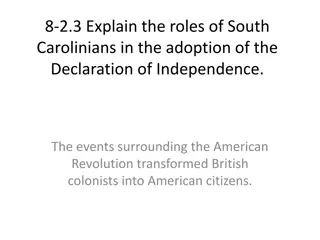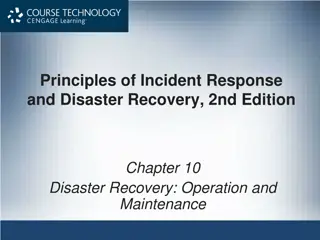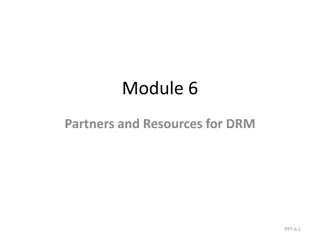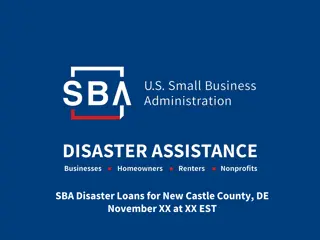Disaster Response and Declaration Protocol for Local Government Units
In times of disaster or calamity, the protocol dictates the immediate convening of the DDRMC and DRRMC, conducting damage surveys, deploying assessment teams, submitting damage reports, and recommending the declaration of a state of calamity. Local government bodies must act swiftly when a significant portion of the population or livelihood is affected, ensuring prompt assistance and protection measures. Additionally, guidelines for epidemic outbreaks are outlined to monitor disease occurrences and clusters effectively.
Download Presentation

Please find below an Image/Link to download the presentation.
The content on the website is provided AS IS for your information and personal use only. It may not be sold, licensed, or shared on other websites without obtaining consent from the author. Download presentation by click this link. If you encounter any issues during the download, it is possible that the publisher has removed the file from their server.
E N D
Presentation Transcript
Whenever disaster/calamity occurs: 1) DDRMC shall convene 2) DRRMC to conduct a survey of affected area within 24 hours to determine extent of casualties & damage; 3) Deploy teams
4) Submission of damage reports by concerned offices/rsand teams 5) Based on damage assessment & evaluation LCE to recommend to the Sanggunian the declaration of a state of calamity, together with appropriate mitigation measures
6) W/in 24 hours from the occurrence of the calamity & acting on the recommendation of the LCE, the Sanggunian shall convene & immediately pass a Resolution declaring their area under a state of calamity
When to or more barangaysare affected by a disaster, the SangguniangBayan concerned shall immediately convene and a pass a Resolution declaring their area under a state of calamity and adopt measures to protect the lives and properties in the area (Reference : NDCC Memo Order No. 4 s. 1998)
At least 20% of the population are affected and in need of emergency assistance or those dwelling units have been destroyed; A great number or at least 40% of the means of livelihood such as banca, fishing boats, vehicles and the like are destroyed;
Widespread destruction of fishponds, crops, poultry & livestock & other agricultural products; Disruption of lifelines such as electricity, potable water system, transport system, communication system & other related systems
For epidemic or outbreak of a disease 1) there is an occurrence of an unusual (more than the previously expected) number of cases of a disease in a given area or among a specific group of people over a particular period of time. To determine whether the number is more than the expected, the number should be comparable during the last five (5) yrs. 2) There is a clustering of cases (cluster is a group of cases in a given area over a particular time
Can be made by the Office of the President or the Sanggunian Calamity area declaration may be enforced in the affected area for a period of one year unless the effect of the disaster is recurring or protracted But if 85% of the repair and rehabilitation works & services has been accomplished, the declaration will be terminated or lifted
Whats your Issues/Concerns Suggestions/Recommendations Lessons Learned
DISASTER - Mitigation - Preparedness - Response - Rehabilitation
The lessening or limitation of the adverse impacts of hazards and related disasters. Include but not limited to the following: Engineering techniques (structural & non- structural), hazard resistant construction, environmental policies and programs, public awareness (early warning system)
Aims to build capacities needed to efficiently manage all types of emergencies and achieve orderly transition from response to sustained recovery. Includes Contingency planning, Stockpiling of equipment & supplies, development of arrangement for coordination, evacuation & public information, training & field exercises supported with legal, institutional & budgetary capacities
Also known as Disaster Relief Provision of emergency services and public assistance during or immediately after a disaster to save lives, reduce health impacts, ensure public safety and meet the basic subsistence needs of the people affected
Measures that ensure the ability of affected communities/areas to restore their normal level and functioning by rebuilding livelihood and damaged infrastructure and increasing the community s organizational capacity
MDRRMC Organization thru EO DRRM Office Echo Seminar for DRRM Formulate Work and Financial Plan (70% pre- disaster for preparedness & mitigation Inventory of Rescue Equipment Drill/Training for Rescue Team Inventory of Resource Center Inventory of Database
For the barangays 1) Organization of BDRRMC -Resolution 2) Establishment of Disaster Operations Center (BarangayHall) Resolution 3) Echo Training on DRRM 4) Work and Financial Plan 5) Hazard Mapping 6) Inventory of Equipment, Search & Recue Group 7) Maintaining a Database





